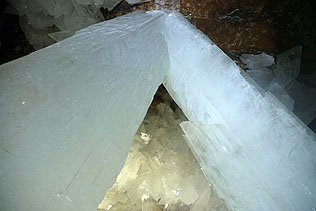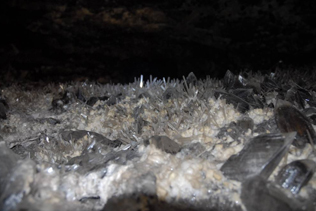|
Large columns of selenite crystal inside. |
About the Crystal Cave. |
The genetic mechanism responsible for the development and formation of the macro crystals, is strictly related to the peculiar geological conditions prevailing in the Naica mine. |
These macro crystals formed underwater in the area where sulphide saturated phreatic thermal waters (52°C), came in contact with oxygen-rich cold waters, naturally infiltrating from the exterior. |
|
|
This geological system is alive and continues the crystallization process, originating small formations of various minerals, even over the surface area. It is an active system, which has filled the voids of the multi-fractured limestone rock, with selenite crystals of extraordinary shapes and sizes, such as those of the famous Crystals’ Cave. |
| These crystals represent the most extraordinary examples of selenite. By chance, four caves of unique characteristics and sizes have been discovered; however the system is very extensive and someday we might learn of another lucky discovery. In 1910, at -120 meters the Swords’ Cave was discovered, a cavity along an 87 meter long corridor, completely covered by crystals up to two meters in length. From this cave the most beautiful crystals were taken to be exhibited in some of the most important museums in the world. |
Almost 100 years later, in April 2000, at -290 meter level another three caverns were discovered: the “Queen’s Eye Cave”, the “Candles’ Cave” and the extraordinary “Crystals’ Cave”, a forest of mega formations, which have added a new dimension to the geology of our planet. |
|
|



